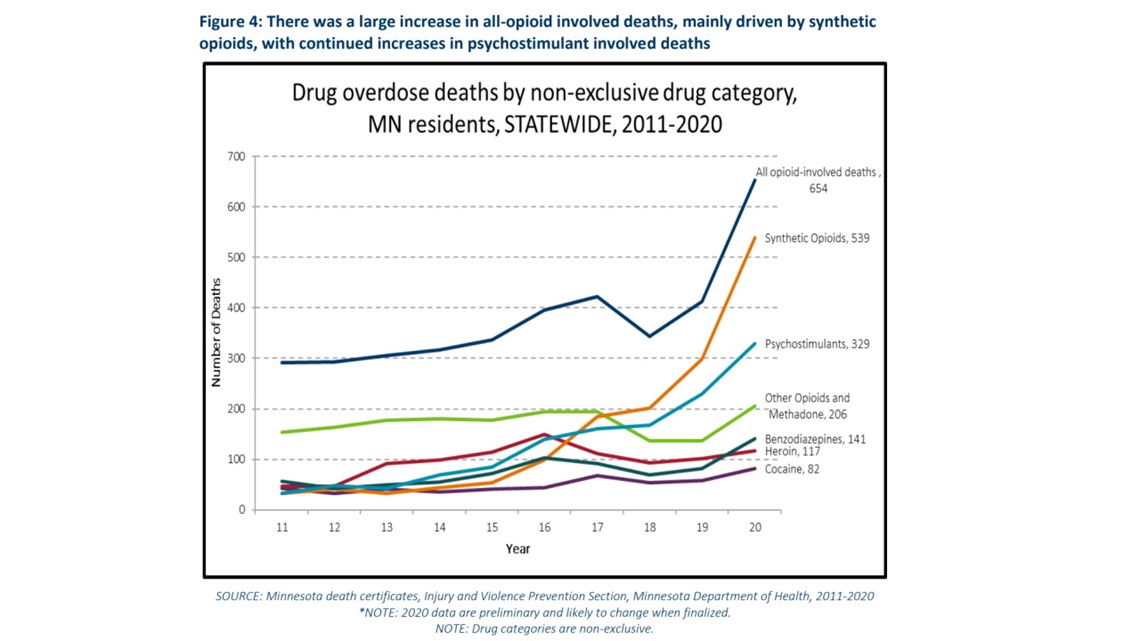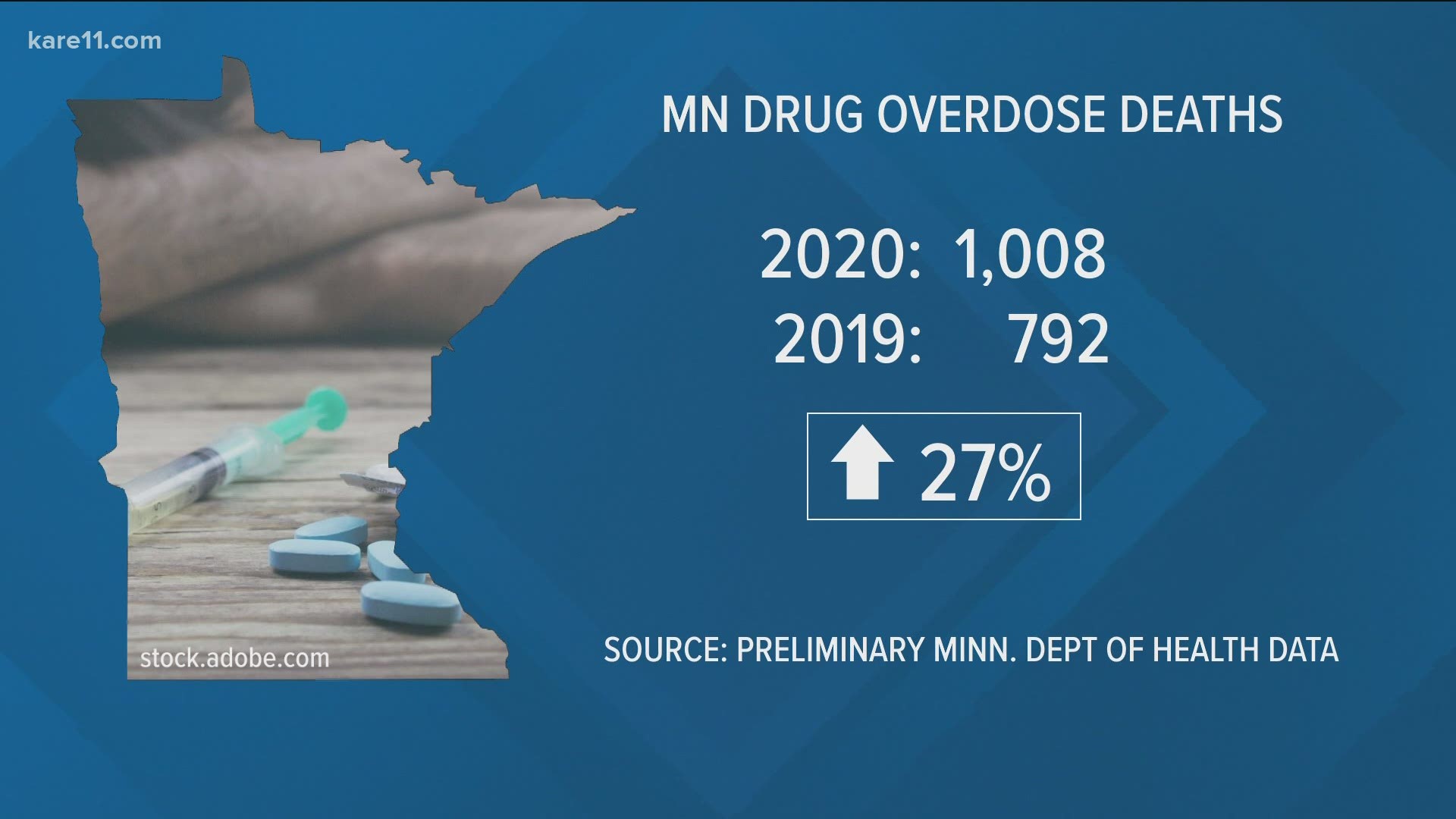ST PAUL, Minn. — The number of Minnesotans who died from drug overdoses rose sharply in 2020, despite a concerted effort to recognize those deaths as public health crisis.
According to the Minnesota Department of Health (MDH) a total of 1,008 people died from drug overdoses statewide in 2020, compared to 792 in 2019. That amounts to a 27% year-over-year increase.
Epidemiologists cautioned that these stats are based on preliminary numbers for 2020, so there's a good chance the actual numbers of deaths will be higher as more reports come in from medical examiners. The preliminary statistics don't distinguish between intentional overdoses and accidental ones.
The data collected by MDH showed that overdoses of all major categories of drugs increased, but opioids - especially synthetic ones - led the way in the death statistics.
Opioid deaths rose by 59%, climbing from 412 in 2019 to 654 in 2020. Synthetic opioids, including fentanyl and fentanyl analogues, were responsible for 82% of all opioid-related deaths. The fentanyl death category alone rose by more than 80% from 2019 to 2020.
Overdose deaths rose in all age groups, but those between the ages of 25 and 34 accounted for the highest number of those fatalities. In that age bracket deaths jumped 57% in 2020 over 2019 figures.
It's a familiar tale to Dori Zacho of Chisago City. She lost her son 29-year-old son Maxx to an accidental overdose of heroin laced with fentanyl in 2019. He had struggled with opioid addiction in the past, something that began at age 18 when he received prescription painkillers for a burn injury.
"Emergency services were there immediately and started giving him Narcan. And gave him six doses of that. But it was just too late for Maxx."
Zacho said her son had been through six treatment programs and had lived drug-free for four and a half years before he relapsed on the day of his fatal overdose.
"Maybe he was thinking this one last time. Unfortunately, like everyone else, it was fentanyl-laced, and it took his life. People don't realize that with fentanyl a relapse can be fatal."
The Zacho family's advice to those dealing with an addicted loved one is to stay focused on the fact that addiction is a disease and not some moral failure. And she said those struggling with addiction should never assume their family has given up on them.
The rise in fatal drug overdoses was also more marked in the 7-county metro area, which includes Anoka, Carver, Dakota, Hennepin, Ramsey, Scott and Washington counties.
The number of people who died of overdoses in the Twin Cities metro area rose by 40% 2020 versus 2019. In the remainder of the state, often referred to as "greater Minnesota," those deaths rose by 21%.
The preliminary numbers also point to a 44% increase in overdose deaths from psychostimulants, including methamphetamines. Deaths from benzodiazepines went up by 70% and fatalities from cocaine rose by 41% year to year.
According to Mary DeLaquil of the MDH Drug Overdose Epidemiology Unit, Minnesota was not unique when it came to these sobering stats in 2020.
"Pretty much every state in the United States has seen a significant increase in overdose deaths," DeLaquil told KARE.
"We can't say for sure what the cause is, but on the national level it's reasonable to believe that the pandemic played a part. Access to treatment probably played a part."
According to the Health Department's opioid dashboard, prescriptions of opioid painkillers have dropped significantly since 2015. The legislature has also passed bills providing immunity from prosecution for those who report overdoses in an effort to save lives.
From the MDH's standpoint all overdose deaths are preventable if people have access to treatment options and life-saving emergency antidote drugs such as Narcan.
Sam Robertson of MDH said the department is stepping up efforts to make sure people can get help with substance abuse disorders closer in their own communities. So, MDH is partnering with community service and harm-reduction agencies to connect their clients to substance abuse treatment services. The state is also working with organizations across the state to increase access to free Narcan.
"This report shows us on the prevention side that we really need to be focusing on public health messaging surrounding the potential for fentanyl being in illicit drugs, public health messaging to all people who use drugs that they should assume there is fentanyl in whatever they are using."
The legislature also passed a bill substantially increasing the registration fees for companies that sell prescription opioid medications in Minnesota, to help pay for the cost of treatment and prevention of opioid addictions. That's a recognition of the role pharmaceutical companies played promoting use of those addictive drugs for long-term chronic conditions.
Minnesota Attorney General Keith Ellison has also brought lawsuits against opioid manufacturers.
There has been speculation that COVID-19's effects on the economy and the mental health of Americans may have been a factor the increase in drug use in both accidental and intentional overdoses.



